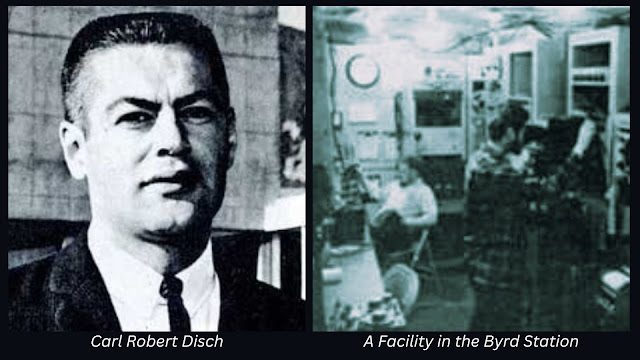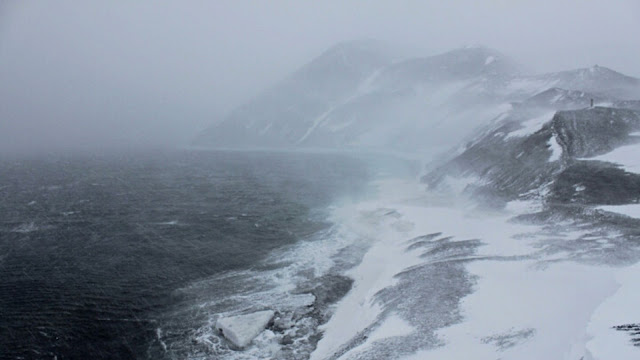Obscure Occurrences : The Disappearance of Carl Robert Disch
Cold, desolate and vastly expansive, Antarctica is the only significant landmass on earth that harbours no permanent inhabitants and remarkably, one that had remained unexplored until a little over a hundred years ago. Despite the fact that the continent is covered in snow and ice, it receives very little snowfall and thus, is classified as a desert. The snow that does exist there has built up over hundreds of years, as it is far too cold to ever melt. For this reason, it has caused the lives of many and ruined many more. One’s existence there seems to fluctuate between endless silence and the deafening sounds of colliding icebergs and howling winds.
 |
| (Source: Hippo Px) |
Baring the relatively few mountain ranges and glaciers, Antarctica is featureless. The vast expanses of brilliant-white snow host no macroflora or permanent macrofauna. Thus, it is no wonder that the unforgiving landscape is considered to be nightmare-inducing. Over the past century, many dark tales have emerged from the continent, from bizarre disappearances to the frenzied killing of pets. It is a place of many mysteries, unwilling to surrender. One such disturbing event, which has endured for over 50 years, occurred on a dark morning in 1985.
Chronology
A year previous to the timeline in question, Carl Robert Disch, a 26-year-old ionospheric physicist from Monroe, had joined the staff at Boulder Laboratories. As a part of his responsibilities, he was asked to join a research team in Antarctica. Although a daunting prospect, Carl agreed to it before finding himself assigned to Byrd station, located approximately 600 miles from the south pole.
 |
| (Source: South Pole Station) |
Over the six months that followed, he spent most of his time working in the Central Propagation Laboratory and his job required him to work long hours at the Radio Noise building, a small hut strategically positioned a mile northwest of the main complex. Despite the distance, the two facilities were connected by a handline, a rope which helped guide the researchers during harsh weather.
Carl himself had made this journey multiple times, so he was familiar with the terrain and the navigations involved. However, on the dark morning of the 8th of May 1965, he would set out from the Radio Noise building for the very last time and get lost into the punishing landmass, never to be seen again.
Carl left the facility at 9:15 am, during nautical twilight, heading for the main complex. The winds were up and the temperature was as low as -44 degrees Fahrenheit, but he was fully attired in Antarctic clothing designed to provide adequate protection. The trek should have taken him no longer than half an hour and thus when Carl had still not reached his destination by 10 am, his colleagues became sufficiently concerned to assemble a search party and deploy it along his intended route. At 11:30 am, a set of footprints was discovered in the vicinity of the Radio Noise building.
The footprints began at the bottom of the ladder attached to the hut, but rather than proceeding South along the handline as they would have expected, they headed west towards the ski way. Carl’s colleagues followed the trial for approximately four miles towards the southwest corners of the station’s outer perimeter before it abruptly stopped. At times, the tracks appeared purposeful, with consistent long paces instead of an uncertain progression, thus suggesting that Carl was not lost or confused.
After refuelling their vehicles, the search team moved back out to the corner of the ski way and performed a three-hour-long search of the area, but it yielded nothing. When they finally decided to go back, blustering 30-knot winds made their safe return extremely difficult. They eventually made it back to base at 6:15 pm following which an extensive search of the supply line, the emergency Jamesway and the fuel dump commenced, but it proved to be less than fruitful.
About an hour later, Carl’s colleagues formed a human chain in order to search the route leading from the base to the ski way, where his footsteps had disappeared. Despite the difficult weather conditions, flood lights were lit and flares were launched every 30 minutes, until a point where the visibility became so poor that these measures became ineffective.
The following day, a third vehicle search party to cover the area along the route leading from the base to the ski way commenced. Despite finding occasional, unblemished tracks moving in the southwestern direction, they abruptly disappeared four miles southwest of the Radio Noise building.
On the morning of the 10th of May 1965, two days after Carl’s disappearance, another extensive search commenced. It consisted of eight men, two vehicles, a Jamesway, provisions and fuel. The search commenced at the main complex, moved in the South and made perpendicular sweeps to the East and West, marking the progress with flags. However, despite clearing the twelve miles beyond the perimeter of the station, nothing was found.
On the 12th of May 1965, the north-eastern and south-western sectors of Byrd Station were searched. Although the weather was favourable, darkness severely hampered their visual range. Over the next two days, the harsh winds and fog hampered the visibility so much that the search became impossible. By the 14th of May, 35 square miles had been covered, but Carl had never been seen again.
Over the weeks that followed, citing the time he had been missing, Carl was presumed dead. A memorial service was held by his friends and family in Monroe, and another by his colleague at Byrd, thus marking the beginning of a mystery which had tragically endured without a sense of closure for more than half a century. The questions that were asked back then are still being asked today. Why did Carl deviate from the usual route and vanish without a trace?
Theories
Over time, a number of theories attempting to explain what might have happened, have surfaced. While some are straightforward and others require an open mind, not one of them is without its flaws.
Succumbed to the Weather Conditions
Perhaps the most popular theory regarding Carl’s disappearance is the previously mentioned weather conditions. When he had left the Radio Noise building, a combination of the blustering winds, poor visibility and the white landscape could have caused him to lose his sense of direction and wander off in the wrong direction. Once he had ventured a short distance, it would have been difficult to regain his bearings.
 |
| (Source: Eli Duke/Flickr) |
However, Carl had made the same journey more than two dozen times before and given his experience, it is unlikely that he would miss the hand line and deviate so far off his route. Considering that the rope had been right in front of the ladder he had used to descend from the Radio Noise building, there is no way he could have missed it even in the low visibility. Furthermore, the fact that he continued walking in a straight line for at least four miles and his tracks did not display uncertain behaviour, challenges the speculation. Moreover, if the footprints were visible to the members of the search party, he could have used those tracks to walk back to the Radio Noise building.
Mental Breakdown
An alternate explanation for Carl’s disappearance suggests that he might have suffered a mental breakdown. It is rumoured that he had been cheated during a card game, moments before his disappearance. Allegedly, he threw his cards onto the table and told his friends that he was going to “visit his friends at the south pole”. The monotonous nature of the terrain could have broken him down mentally while he had left the building and walked away to clear his head.
However, a man of his experience would have known that pursuing such an action would have been suicidal considering the hostile environment. Although it is understandable that trivial issues could be blown out of proportion in the aforementioned conditions, it is difficult to understand why the successful young man would have reacted that way.
Paranormal
Unsurprisingly, theories suggesting supernatural elements have also been put forward. Investigators have stuck to the fact that the footprints had come to an abrupt stop in the middle of nowhere. While sceptics suggest that further footprints could have been covered in snow, believers of the paranormal argue that the footsteps just stopped as though Carl had simply vanished.
While the former notion is plausible, several members of the search party reported seeing unusual lights and hearing strange noises in the vicinity, both before and after Carl’s disappearance. However, the source of the oddities was never found. Another strange element to this story is the fact that Gus, Carl’s Huskie, went missing a few days later. But considering the fact that this was never officially confirmed, the theory is far from conclusive.
Involvement of the Soviet Union
One possibility that is rarely considered is the involvement of the Soviet Union. There exists a story about a British Royal Navy Commander attached to a survey group in Antarctica, who disappeared during the Cuban Missile Crisis of 1962 under similar circumstances. As events unfolded, it was discovered that the man had been secretly working for the Soviet Union and that he was picked up by them just before his cover blew up.
The period of Carl’s disappearance indeed coincided with the Cold War, and as a specialist in his field, he would have been a valuable asset. This also explains the strange lights and noises reported in the region.
However, the theory loses its footing when the massive distance between Byrd Station and the neighbouring coastline is taken into consideration.
Conclusion
With more questions than answers, there seems to be no conclusive explanation for the disappearance of Carl Robert Disch. As the details about the occurrence have seemingly faded over the years, the probability of establishing a definitive explanation seems to be out of the picture. After all, the monotonous landscape of Antarctica has a way of keeping its secrets.
Post a Comment